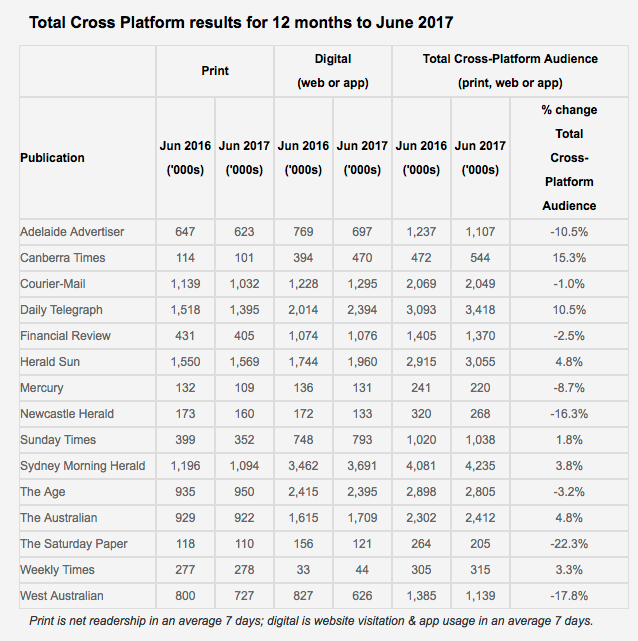Adelaide’s declining media power
In Media Week today, an Adelaide media executive is given the axe with his job going interstate, football propels a local news service to new highs, and the latest newspaper readership data has a local sting.


Media agency lops local executive
In another sign of Adelaide’s declining significance in media and advertising, national media agency Starcom has axed its local general manager in favour of running the SA office out of Melbourne.
GM Mark Clemow was appointed in 2013, with the media planning and buying agency saying at the time that it had a “strong commitment to South Australia”.
He’s now been sent on his way (and can’t comment), with South Australian operations to be run out of Melbourne.
The axing has been greeted with uneasiness in industry circles because of what it says about the state’s declining significance in the advertising industry – itself a symptom of a broader economic malaise.
Starcom Australia CEO Toby Barbour confirmed to InDaily that the local office would be managed by Melbourne GM Naomi Johnson.
“When Starcom transitioned to the new Publicis Media model [Starcom’s parent company], it was important that we moved from separate businesses in each city, to one united brand,” he said in a statement. “While this approach offers efficiencies, more importantly it allows us to access a range of national talent to deliver client solutions every day.
“There is no change in our commitment to the Adelaide market and no more changes planned. Mark has led Starcom Adelaide professionally and we wish him all the best for the future.”
Clemow’s departure comes two years after rival agency MEC grabbed the biggest plum in town – the State Government’s master contract for advertising planning and buying.
Local industry figures were reluctant to go on the record, but one executive suggested that the decision shows how South Australia has become a “company” town – with the twist that the Government is the only game in town. Without the Government account, thought to be worth about $30 million, the writing was on the wall for Starcom, he said, adding that a better option might be to have a panel of media agencies, instead of funneling all of the campaign work through one company.
Some observers are worried about the long-term future of the local media buying scene (MEC’s $6 million account with Radio Rentals SA recently went east, to independent agency Nunn Media).
Apart from the Government work, the most substantial local account is Mitsubishi – reportedly worth about $40 million – which was retained by the local office of MEC last year.
Before joining Starcom, Clemow had a 25-year career in the field, including as head of government communications and roles with The Advertiser and TMP Worldwide.
Footy boots news sky high
Seven news enjoyed its highest ratings in the best part of a decade last weekend, thanks to the exquisite timing of the Showdown.
The bulletin, hosted by Jessica Adamson, was aired a half-time in the Crows-Power match, and managed to garner a peak of 254,000 viewers.
The number crunchers at Seven reckon this was the highest-rating Adelaide news bulletin on any station since July 2009 (when Seven pulled in nearly 273,000 viewers).
The Showdown itself grabbed about 250,000 viewers – the highest-rating cross-town match since the May 2015 edition of the epic clash.
The Oztam ratings this week have some other interesting bits and pieces, particularly for those curmudgeons who hate reality TV – in South Australia, at least, it seems you’re not alone.
On Wednesday night, for example, more people in Adelaide watched ABC comedies Utopia (77,000 viewers) and Shaun Micallef’s Mad as Hell (80,000) than Nine’s The Block (75,000) or Ten’s The Bachelor (51,000).
Bad news for Tiser in readership figures
Roy Morgan Research readership figures for June show a patchy performance by the nation’s newspapers over the past 12 months.
With a few exceptions, print readership continues to fall. Despite this, an increase in digital readership has helped some titles to grow.
The Sydney Morning Herald has cemented its place as the most powerful newspaper masthead (although bear in mind that these figures don’t include widely read digital-only news sites like news.com.au, The Guardian and The Daily Mail).
Also bear in mind that the newspaper industry hates these figures, which are based on survey data. The industry prefers its own, much more positive “Enhanced Media Metrics Australia” data.
Roy Morgan shows the Tiser lost 10.5 per cent of its audience in 12 months, with a surprisingly large drop in digital users. By contrast, its News Corp stablemate, The Daily Telegraph, increased readership by exactly the same percentage.
Still, some other editors have bigger headaches: the left-wing Saturday Paper bled 22.3 per cent of readers, and the West Australian dropped by 17.8 per cent.

The Tiser’s editor, Sam Weir, has the chance this week to hear exactly what his boss, Rupert Murdoch, feels about the Adelaide paper’s performance.
Weir is reportedly one of a handful of News Corp editors summoned to Los Angeles for an annual grilling by the media magnate.
Media Week is a regular column about the media, marketing and PR industries in South Australia.




